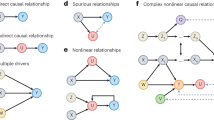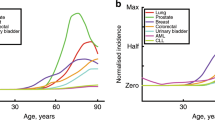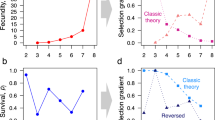Abstract
The evolutionary theory of ageing explains why ageing occurs, giving valuable insight into the mechanisms underlying the complex cellular and molecular changes that contribute to senescence. Such understanding also helps to clarify how the genome shapes the ageing process, thereby aiding the study of the genetic factors that influence longevity and age-associated diseases.
This is a preview of subscription content, access via your institution
Access options
Subscribe to this journal
Receive 51 print issues and online access
We are sorry, but there is no personal subscription option available for your country.
Buy this article
- Purchase on SpringerLink
- Instant access to full article PDF
Prices may be subject to local taxes which are calculated during checkout

Similar content being viewed by others
References
Kirkwood, T. B. L. & Cremer, T. Cytogerontology since 1881: a reappraisal of August Weismann and a review of modern progress . Hum. Genet. 60, 101–121 (1982).
Rose, M. R. Evolutionary Biology of Ageing (Oxford Univ. Press, New York, 1991).
Austad, S. N. Why We Age (Wiley, New York, 1997).
Kirkwood, T. B. L. Time of Our Lives: The Science of Human Ageing (Oxford Univ. Press, New York, 1999).
Finch, C. E. Longevity, Senescence and the Genome (Chicago Univ. Press, Chicago, 1990).
Charlesworth, B. Evolution in Age-Structured Populations (Cambridge Univ. Press, Cambridge, 1994).
Medawar, P. B. An Unsolved Problem of Biology (Lewis, London, 1952 ).
Martin, G. M., Austad, S. N. & Johnson, T. E. Genetic analysis of aging: role of oxidative damage and environmental stresses. Nature Genet. 13, 25–34 (1996).
Williams, G. C. Pleiotropy, natural selection and the evolution of senescence. Evolution 11, 398–411 ( 1957).
Kirkwood, T. B. L. Evolution of ageing. Nature 270, 301– 304 (1977).
Kirkwood, T. B. L. Human senescence. BioEssays 18, 1009– 1016 (1996).
Phelan, J. P. & Austad, S. N. Natural selection, dietary restriction and extended longevity. Growth Dev. Aging 53, 4–6 (1989).
Berry, R. J. & Bronson, F. H. Life history and bioeconomy of the house mouse. Biol. Rev. 67, 519– 550 (1992).
Bell, G. Evolutionary and nonevolutionary theories of senescence. Am. Nat. 124, 600–603 ( 1984).
Martinez, D. E. Mortality patterns suggest lack of senescence in hydra. Exp. Gerontol. 33, 217–225 ( 1997).
Rose, M. R. & Charlesworth, B. A test of evolutionary theories of senescence. Nature 287, 141– 142 (1980).
Luckinbill, L. S., Arking, R., Clare, M. J., Cirocco, W. C. & Buck, S. A. Selection of delayed senescence in Drosophila melanogaster. Evolution 38, 996– 1003 (1984).
Partridge, L., Prowse, N. & Pignatelli, P. Another set of responses and correlated responses to selection on age of reproduction in Drosophila melanogaster. Proc. R. Soc. Lond. B 266, 255–261 (1999).
Buck, S., Vettraino, J., Force, A. G. & Arking, R. Extended longevity in Drosophila is consistently associated with a decrease in larval viability. J. Gerontol. A 55, B292–B301 (2000).
Zwaan, B. J., Bijlsma, R. & Hoekstra, R. F. Direct selection on lifespan in Drosophila melanogaster . Evolution 49, 649– 659 (1995).
Stearns, S. C., Ackermann, M., Doebeli, M. & Kaiser, M. Experimental evolution of aging, growth, and reproduction in fruitflies. Proc. Natl Acad. Sci. USA 97, 3309– 3313 (2000).
Sgró, C. M. & Partridge, L. A delayed wave of death from reproduction in Drosophila. Science 286, 2521–2524 (1999).
Van Voorheis, W. A. & Ward, S. Genetic and environmental conditions that increase longevity in Caenorhabditis elegans decrease metabolic rate. Proc. Natl Acad. Sci. USA 95, 11399–11403 (1999).
Johnson, T. E. & Hutchinson, E. W. Absence of strong heterosis for life span and other life history traits in Caenorhabditis elegans. Genetics 134, 465– 474 (1993).
Walker, D. W., McColl, G., Jenkins, N. L., Harris, J. & Lithgow, G. J. Evolution of lifespan in C. elegans. Nature 405, 296– 297 (2000).
Stearns, S. C. & Partridge, L. in Handbook of the Biology of Aging (eds Masoro, E. J. & Austad, S. N.) (Academic, San Diego, in the press).
Service, P. M., Hutchinson, E. W. & Rose, M. R. Multiple genetic mechanisms for the evolution of senescence in Drosophila melanogaster. Evolution 42, 708–716 (1988).
Hughes, K. A. & Charlesworth, B. A genetic analysis of senescence in Drosophila. Nature 367, 64– 66 (1994).
Charlesworth, B. & Hughes, K. A. Age-specific inbreeding depression and components of genetic variance in relation to the evolution of senescence. Proc. Natl Acad. Sci. USA 93, 6140–6145 (1996).
Promislow, D. E. L., Tatar, M., Khazaeli, A. A. & Curtsinger, J. W. Age-specific patterns of genetic variation in Drosophila melanogaster. I. Mortality. Genetics 143, 839– 848 (1995).
Shaw, F. H., Promislow, D. E. L., Tatar, M., Hughes, K. A. & Geyes, C. J. Toward reconciling inferences concerning genetic variation in Drosophila melanogaster. Genetics 152, 553–566 (1999).
Austad, S. N. Retarded senescence in an insular population of opossums. J. Zool. 229, 695–708 ( 1993).
Keller, L. & Genoud, M. Extraordinary lifespans in ants: a test of evolutionary theories of aging. Nature 389 , 958–960 (1997).
Ricklefs, R. E. Evolutionary theories of aging: confirmation of a fundamental prediction, with implications for the genetic basis and evolution of life span. Am. Nat. 152, 24–44 ( 1998).
Sohal, R. S., Ku, H.-H. & Agarwal, S. Biochemical correlates of longevity in two closely-related rodent species. Biochem. Biophys. Res. Comm. 196, 7–11 (1993).
Ku, H.-H., Brunk, U. T. & Sohal, R. S. Relationship between mitochondrial superoxide and hydrogen-peroxide production and longevity of mammalian-species. Free Radical Biol. Med. 15, 621–627 (1993).
Barja, G. & Herrero, A. Oxidative damage to mitochondrial DNA is inversely related to maximum life span in the heart and brain of mammals . FASEB J. 14, 312–318 (2000).
Herrero, A. & Barja, G. 8-oxo-deoxyguanosine levels in heart and brain mitochondrial and nuclear DNA of two mammals and three birds in relation to their different rates of aging. Aging Clin. Exp. Res. 11, 294–300 ( 1999).
Sell, D. R. et al. Longevity and the genetic determination of collagen glycoxidation kinetics in mammalian senescence. Proc. Natl Acad. Sci. USA 93, 485–490 (1996).
Kirkwood, T. B. L. DNA, mutations and aging. Mut. Res. 219, 1–7 (1989).
Grube, K. & Bürkle, A. Poly(ADP-ribose) polymerase activity in mononuclear leukocytes of 13 mammalian species correlates with species-specific life span. Proc. Natl Acad. Sci. USA 89, 11759–11763 (1992).
Ogburn, C. E. et al. Cultured renal epithelial cells from birds and mice: enhanced resistance of avian cells to oxidative stress and DNA damage. J. Gerontol. 53, B287–B292 ( 1998).
Kapahi, P., Boulton, M. E. & Kirkwood, T. B. L. Positive correlation between mammalian life span and cellular resistance to stress. Free Radical Biol. Med. 26, 495–500 (1999).
Sohal, R. S. & Donato, H. Effects of experimentally altered life span on the accumulation of fluorescent age pigment in the housefly, Musca domestica. Exp. Gerontol. 13, 335–341 (1978).
Austad, S. N. Life extension by dietary restriction in the bowl and doily spider, Frontinella pyramitela. Exp. Gerontol. 24, 83– 92 (1989).
Klass, M. & Hirsh, D. Non-ageing developmental variant of Caenorhabditis elegans. Nature 260, 523–525 (1976).
Anderson, G. L. Responses of dauer larvae of Caenorhabditis elegans (Nematoda: Rhabditidae) to thermal stress and oxygen deprivation. Can. J. Zool. 56, 1786–1791 (1978).
Lithgow, G. J. in Handbook of the Biology of Aging (eds Schneider, E. L. & Rowe, J. W.) 55–73 (Academic, San Diego, 1996).
Vanfleteren, S. L. & De Vreese, A. Rate of aerobic metabolism and superoxide production rate potential in the nematode Caenorhabditis elegans. J. Exp. Zool. 274, 93– 100 (1996).
Weindruch, R. & Walford, R. L. The Retardation of Aging and Disease by Dietary Restriction (Thomas, Springfield, IL, 1988).
Masoro, E. J. Influence of caloric intake on aging and on the response to stressors. J. Toxicol. Environ. Health B Crit. Rev. 1, 243– 257 (1998).
Walford, R. L. & Spindler, S. R. The response to calorie restriction in mammals shows features also common to hibernation: a cross-adaptation hypothesis. J. Gerontol. 52, B179–B183 (1997).
Shanley, D. P. & Kirkwood, T. B. L. Calorie restriction and aging: a life history analysis. Evolution 54, 740–750 (2000).
Stearns, S. C. The Evolution of Life Histories (Oxford Univ. Press, New York, 1992).
Partridge, L. & Barton, N. H. On measuring the rate of ageing . Proc. R. Soc. Lond. B 263, 1365– 1371 (1996).
Hill, K. & Hurtado, A. M. Ache Life History: the Ecology and Demography of a Foraging People (de Gruyter, New York, 1996).
Hamilton, W. D. The moulding of senescence by natural selection. J. Theor. Biol. 12, 12–14 ( 1966).
Kirkwood, T. B. L. & Holliday, R. in The Biology of Human Ageing (eds Collins, A. J. & Bittles, A. H.) 1– 16 (Cambridge Univ. Press, Cambridge, 1986).
Austad, S. N. Menopause: an evolutionary perspective. Exp. Gerontol. 29, 255–263 (1994).
Peccei, J. S. The origin and evolution of menopause: the altriciality-lifespan hypothesis . Ethol. Sociobiol. 16, 425– 449 (1995).
Hawkes, K., O'Connell, J. F., Jones, N. G. B., Alvarez, H. & Charnov, E. L. Grandmothering, menopause, and the evolution of human life histories. Proc. Natl Acad. Sci. USA 95, 1336–1339 ( 1998).
Shanley, D. P. & Kirkwood, T. B. L. Evolution of the human menopause. BioEssays (in the press).
Packer, C., Tatar, M. & Collins, A. Reproductive cessation in female mammals. Nature 392, 807–822 ( 1998).
Risch, N., Reich, E. W., Wishnick, M. M. & McCarthy, J. G. Spontaneous mutation and parental age in humans. Am. J. Hum. Genet. 41, 218–248 ( 1987).
Gavrilov, L. A. & Gavrilova, N. S. Parental age at conception and offspring longevity. Rev. Clin. Gerontol. 7, 5–12 (1997 ).
Wallace, D. C. Mitochondrial diseases in man and mouse. Science 283 , 1482–1488 (1999).
Cummins, J. M. in Female Reproductive Aging (eds Te Velde, E. R., Pearson, P. L. & Broekmans, F. J.) 207–224 (Parthenon, Carnforth, UK, 2000).
Vieira, C. et al. Genotype-environment interaction for quantitative trait loci affecting life span in Drosophila melanogaster. Genetics 154 , 213–227 (2000).
Lee, C. K., Klopp, R. G., Weindruch, R. & Prolla, T. A. Gene expression profile of aging and its retardation by caloric restriction . Science 285, 1390–1393 (1999).
Finch, C. E. & Kirkwood, T. B. L. Chance, Development and Aging (Oxford Univ. Press, New York, 2000).
Vaupel, J. W. et al. Biodemographic trajectories of longevity. Science 280, 855–860 (1998).
Service, P. M., Hutchinson, E. W., Mackinley, M. D. & Rose, M. R. Resistance to environmental-stress in Drosophila melanogaster selected for postponed senescence. Physiol. Zool. 58, 380–389 (1985).
Tatar, M. Evolution of senescence: longevity and the expression of heat shock proteins . Am. Zool. 39, 920–927 (1999).
Lin, Y. J., Seroude, L. & Benzer, S. Extended life-span and stress resistance in the Drosophila mutant methuselah. Science 282 , 943–946 (1998).
Migliaccio, E. et al. The p66shc adaptor protein controls oxidative stress response and life span in mammals. Nature 402, 309–313 (1999).
Author information
Authors and Affiliations
Rights and permissions
About this article
Cite this article
Kirkwood, T., Austad, S. Why do we age?. Nature 408, 233–238 (2000). https://doi.org/10.1038/35041682
Issue Date:
DOI: https://doi.org/10.1038/35041682



